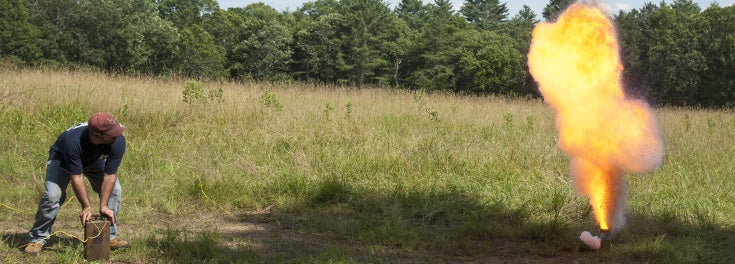
Imagine getting class credit for blowing stuff up. For students at URI’s energetic materials lab, it’s all in a day’s work. The lab has a long-winded official name – the Center of Excellence in Explosives, Detection, Mitigation, Response, and Characterization – but it’s definitely not stodgy. In fact, it offers one of the most extensive explosives curriculums in the country.
The Center involves undergraduate students and graduate students in research and outreach involving identification, detection and neutralization of materials used to make explosives.
Funded by a $5.15 million grant from the Department of Homeland Security, the Center at URI was among the first – a testament to URI’s reputation as a national leader in explosives, energetic materials and pyrotechnics. And no doubt, it was also what led Department of Homeland Security Secretary Janet Napolitano to appoint URI President David M. Dooley to the Homeland Security Academic Advisory Council. The Center involves undergraduate students and graduate students in research and outreach involving identification, detection and neutralization of materials used to make explosives.
For a company in the business of detection, they tested a thermal “gun” device that could observe the difference between “the normal thermal emission of your body and the emissions of something you might have under your garment that you wouldn’t normally see,” said Chemistry Professor Jimmie Oxley, one of the world’s top explosives experts and co-director of the Center. And for the Metropolitan Transportation Authority in New York, they developed non-lethal training aids to help dogs detect the highly volatile peroxide-based explosives frequently by terrorists. And yes, they build and set off bombs, too.
Professor Oxley has become a go-to resource for the FBI, the Federal Aviation Administration,and law enforcement agencies across the country, the United Kingdom, and Israel. Bomb squads sought her out for guidance after the 2005 bombings in London. She collaborated with the FBI on simulations of the 1993 World Trade Center bombing and with British officials to look at large fertilizer bombs.
But you’ll work with other nationally and internationally renowned researchers involved in the Center too. For example, to help nations build structures better able to withstand explosions, Engineering Professor Arun Shukla and his students study the effect of blast loading on various novel structural configurations and materials. With Chemistry Professor Bill Euler, you’ll study and develop methods for detecting trace evidence in explosives and related molecules using flourescent techniques. Threats to the travelling public from such improvised explosive devices as the failed attempt of the “underwear bomber” have prompted Professor Otto Gregory and his students to develop a thermodynamic-based sensor that can reliably and quickly detect tiny amounts of energetic materials used to make explosives in luggage and clothing.
“We do science every day. The work wouldn’t get done with the students. But it’s more than just hands-on. You need that interaction with colleagues to advance. It’s a very active field. Students like to tease that takes a little longer to graduate from this program but they don’t have to waste any time looking for a job afterwards.”
Related Links:
Watch the September 29, 2010 Discovery Channel Daily Planet segment on how Oxley and her team test the explosiveness of suspect materials.
Read the September 7, 2012 Popular Science article: “The Labs That Go Boom: The DHS Center of Excellence Destroys IEDs”
Read our most recent news release: “In heat of summer, Jimmie Oxley’s research goes to dogs, devices, undies”
Wall Street Journal article “A Primer in PETN” after the Christmas day bombing attempt in Detroit
New York Times article “Explosive on Flight 253 Is Among Most Powerful”
Time article “Why It’s Not Easy to Detonate a Bomb on Board”
